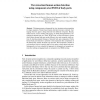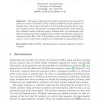146
click to vote
AMDO
2008
Springer
15 years 2 months ago
2008
Springer
This paper presents a general analysis framework towards exploiting the underlying hierarchical and scalable structure of an articulated object for pose estimation and tracking. Th...
137
click to vote
AMDO
2008
Springer
15 years 2 months ago
2008
Springer
This paper presents a framework for view-invariant action recognition in image sequences. Feature-based human detection becomes extremely challenging when the agent is being observ...
91
Voted
AMDO
2008
Springer
15 years 2 months ago
2008
Springer
This paper presents a method of interpolating between two or more general displacements (rotation and translation). The resulting interpolated path is smooth and possesses a number...
111
click to vote
AMDO
2008
Springer
15 years 2 months ago
2008
Springer
We present a system that can segment articulated, non-rigid motion without a priori knowledge of the number of clusters present in the analyzed scenario. We combine existing algori...
145
click to vote
AMDO
2008
Springer
15 years 2 months ago
2008
Springer
Hand-gesture recognition presents a challenging problem for computer vision due to the articulated structure of the human hand and the complexity of the environments in which it is...
122
click to vote
AMDO
2008
Springer
15 years 2 months ago
2008
Springer
Recently many methods for human articulated body tracking were proposed in the literature. These techniques are often computationally intensive and cannot be used for Human-Compute...
AMDO
2008
Springer
15 years 2 months ago
2008
Springer
Many real-time algorithms for mesh deformation driven by animation of an underlying skeleton make use of a set of per-bone weights associated with each vertex. There are few unguid...
143
click to vote
AMDO
2008
Springer
15 years 2 months ago
2008
Springer
We present a human body motion tracking system for an interactive virtual simulation training environment. This system captures images using IR illumination and near-IR cameras to ...
109
click to vote
AMDO
2008
Springer
15 years 2 months ago
2008
Springer
We present a technique for face recognition in videos. We are able to recognise a face in a video sequence, given a single gallery image. By assuming that the face is in an approxi...
110
click to vote
AMDO
2008
Springer
15 years 2 months ago
2008
Springer
This paper addresses the problem of real-time location of the joints or centres of rotation (CoR) of human skeletons in the presence of missing data. The data is assumed to be 3d m...




